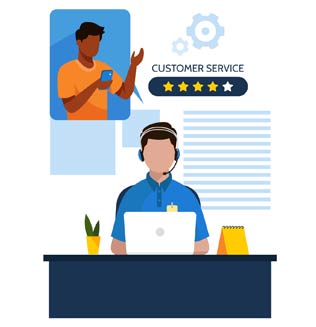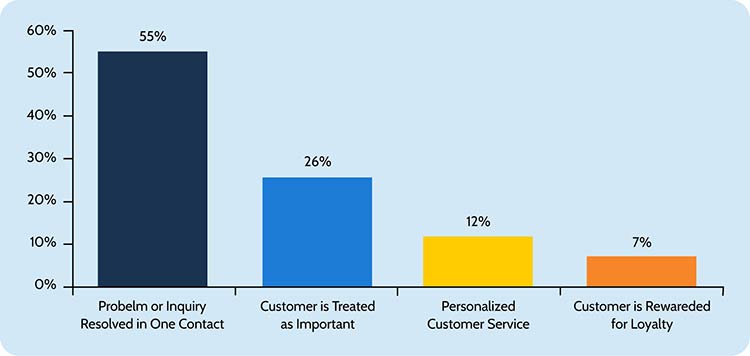Customer Service Matters
Customer service matters because when it's great, it helps retain customers, which can drive revenue growth and higher profitability. Providing great customer service is essential for improving customer retention, which is one of the most effective strategies to ensure company profitability.
In many cases, when an organization is struggling with declining revenue or low operating profits, the priorities tend to be investing in ways to reduce operating cost inefficiencies and sales initiatives but not investing in improving the contact center customer service.

It might seem counterintuitive to invest in the contact center customer service to improve the company's revenue and operating profit. However, SQM's view is that a contact center, in many cases, is the secret weapon for improving a company's customer retention, sales, and profits.
After all, the contact center agents interact with customers daily. Still not convinced? Read the following 10 customer experiences (CX) research facts to know why great customer service matters to improve customer relationships and profits.
The 10 CX research facts to know are based on SQM's experience of measuring and benchmarking over 500 leading North American contact centers and surveying over 7 million customers who used a contact channel. SQM has been conducting contact center CX benchmarking studies since 1996.
Why Great Customer Service Matters –10 CX Facts to Know

Going from Good to Great Customer Service Challenge
At SQM, we believe that contact centers need to measure their customer service impact on the overall relationship with the organization. There are many Voice of the Customer (VoC) metrics that a contact center can use to determine if they are providing great customer service. At SQM, to effectively assess if a contact center delivers great customer service, we conduct a post-contact survey within 1 business day of the interaction using phone, IVR, and email survey collection methods asking a customer service greatness-rating question.
Of the over 500 contact centers, SQM benchmarks on an annual basis, only 5% of them achieved our world-class customer service standard of 65% or higher greatness (top box response) rating. Most contact centers' SQM measures for customer service would be classified as good or average performers. Good to Great, author James Collins suggests, "good is the enemy of great because it is one of the key reasons, so few companies become great." You could make the argument that good customer service is also the enemy of the contact center industry.

Customer Retention is Cheaper than Customer Acquisition
An often-quoted customer retention statistic is that it costs five times more to attract a new customer than it does to retain one. Moreover, an increase in customer retention of merely 5% can equate to an increase in profit of 25%. The increase in profits is due to retaining customers, which reduces sales costs, and existing customers are more likely to purchase more services or products from you than new customers. For many contact centers, retaining customers represents the biggest opportunity to add true value to their organization.

Great Customer Service Can Generate Increase in Sales
Great customer service isn't just about customer retention; it's also an effective approach to increase revenue. Your existing customers can be one of your best sources for improving sales by cross-selling and upselling to them. However, the customer typically becomes irritated if a call center agent cross-sells before resolving the inquiry or problem. Therefore, the customer's needs must be resolved before the agent has earned the right to move on to any sales activity. However, when a customer's call is resolved, the customer cross-selling acceptance rate increases up to 20%.

Reduce Operating Costs by Focusing on Customer Service
One of the best ways to reduce operating costs is to improve customer service. Most customers experiencing FCR would describe the contact center experience as either good or great customer service. Providing customers with an FCR experience not only delivers great customer service but lowers operating costs. For example, for every 1% improvement in FCR, you reduce your call center operating costs by 1%. For a call center performing at the FCR industry average of 70%, potentially 30% of customers will have to call back because their issue was not resolved on the first call. A 1% improvement in their FCR performance equals $286,000 in annual operational savings for the average midsize call center.

High Customer Satisfaction Requires First Call Resolution
As most people know, customer service is an essential component of a contact center. It offers assistance to customers before, during, and after they purchase a product or service. Your organization might have excellent products and low cost, but if your customer service is poor, it will negatively affect your overall customer relationships and brand image.
For example, the average customer satisfaction (Csat) drops 15% (top box response) every time a customer calls back to resolve their initial call. So for every 1% improvement in FCR, there is a 1% improvement in customer service Csat. As a result, the FCR is the highest correlated metric of all contact center internal or external metrics to customer service Csat. Put differently, FCR and call resolution are the strongest drivers for delivering great customer service. Therefore, you can make a strong business case that FCR is a proxy for great customer service.

High FCR and Csat Can Drive High Employee Satisfaction
The level of stress is very high for the agent who handles the second or third call when a customer's issue was not resolved on the initial call. Most contact center managers understand that high employee satisfaction (Esat) can provide high customer service Csat, but high FCR and Csat can also drive high Esat. So for every 1% improvement in FCR, there is a 1% to 5% improvement in Esat. Therefore, contact centers with high FCR and Csat tend to have high Esat. Conversely, contact centers with low FCR and Csat tend to have low Esat. Put simply, FCR impact goes both ways for Esat (e.g., low FCR can drive low Esat, and high FCR can drive high Esat).

FCR is the Driver for Increasing Transactional Net Promoter Score
A transactional Net Promoter Score (NPS) is based on using a contact channel (e.g., call center, email, chat, website), which is different from the traditional perceptional NPS based on the overall relationship a customer has with a company. To answer whether FCR positively impacts transactional NPS, we surveyed customers who used a call center with leading North American organizations within one business day.
SQM Group's research shows that every 1% improvement in First Call Resolution increases transactional NPS by 1.4 points for the average contact center. Therefore, FCR and transactional NPS have a statistical correlation of .64, which would be considered high and shows that FCR positively impacts transactional NPS. The average contact center FCR is 70%, and their NPS is 48. NPS goes down by 18 points for each additional call made.

Customers Tell Others About their Customer Experiences
Customers will tell friends, family, and coworkers about their experience using a contact channel. Unfortunately, many customers do not share their contact center experience because the experience is unmemorable. It is difficult for customers to be motivated to tell others about their experience when the call is so short. Furthermore, for the call center channel, 70% of customers experience FCR. In most cases, their CX is easily forgotten within one day of their call when FCR is achieved.
Conversely, customers are more likely to remember a poor call center customer experience and tell more people than if they had a positive experience. For example, SQM research shows that 75% of customers whose call was unresolved and very dissatisfied with their contact center experience will tell three people about their poor experience. Conversely, satisfied customers (FCR achieved) will tell only one person. Clearly, call centers need to make the experience a more positive, memorable experience resolving an inquiry or problem for them to tell others.

Customers Expect Inquiry Resolution in 1 Contact Using 1 Channel
SQM research shows that 93% of customers using the call center channel and 72% of customers using the website channel expect to resolve their inquiry or problem in one contact. So when the mission is to deliver a great CX on any contact channel used by the customer, One Contact Resolution (OCR) is what today's connected customers really want for CX. However, OCR is a more challenging metric to achieve than First Call Resolution (FCR) because OCR factors whether or not other channels were used, and FCR only factors in one channel being used.
An alarming 42% of customers cannot resolve their inquiry or problem on the first contact and contact channel. Given that only 58% of customers have an OCR experience, it should be viewed as a huge wake-up call for the contact center industry to measure the customer's entire experience (i.e., all contact channels used) trying to resolve the same inquiry or problem. The following figure shows what is most important to customers when interacting with an organization to resolve an inquiry or problem.
Figure 1: What is Most Important to Customers When Interacting with an Organization

Great Customer Service is a Competitive Advantage
Great customer service (e.g., FCR is achieved) can be an outstanding source of differentiation for a company. Other researchers show, 60% of customers stop doing business with a brand after one poor service experience. Moreover, SQM research shows, 95% of this churn is preventable if the customer's problem is resolved during their first call. That means if you provide great customer service, you'll not only retain your customers, but you'll acquire your competitors' as well.
SQM research reveals that only 5% of customers expressed their desire to stop doing business with a company when FCR is achieved. However, when it took two or more calls to resolve an inquiry, 9% of customers expressed their intent to defect, and an alarming 25% of customers expressed their intent to defect if their call was unresolved. Unfortunately, most organizations do not know which customer's call goes unresolved.
According to Reichheld (1996), "In general, the longer a customer stays with a company, the more that customer is worth. Long-term customers buy more, take less of a company's time, are less sensitive to price, and bring in new customers. Best of all, they have no acquisition or start-up cost. Long-term customers are worth so much that in some industries, reducing customer defections by as little as five points – from, say, 15% to 10% per year – can double profits."
Figure 2: Impact Of FCR And Call Resolution On Customer Defections

Quick Related Links
First Call Resolution Definition First Call Resolution PPT First Call Resolution Benefits
First Call Resolution Strategies First Call Resolution Operating Philosophy Call Handling Call Study Intelligent Skill-Based Routing CRM Average Speed of Answer Call Resolution Delivery Model Concierge Service Handling Customer Complaints VoC Performance Management Good to Great Customer Service

